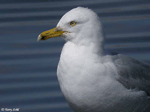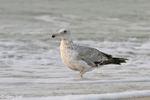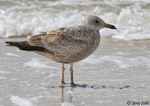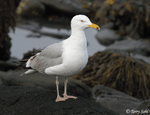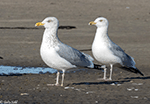Herring Gull
Larus argentatus
| Length: 22 to 26 inches | Wingspan: 54 to 58 inches | Seasonality: Migrant / Winter |
| ID Keys: Black wingtips with white spots, pale yellow eyes, red spot on bill, pink legs. | ||
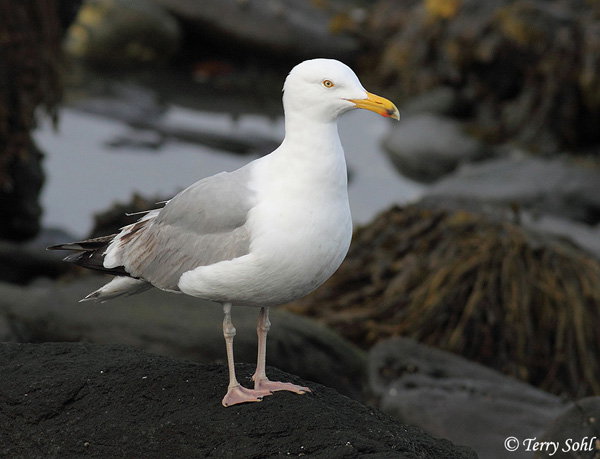 Herring
Gulls are one of the most familiar and widespread gulls in
North America, with an almost identical subspecies also found in Europe and
Asia. Herring Gull numbers were greatly reduced in the 19th
century, but are now numerous and widespread. Like many other gull species,
Herring Gulls have adapted well to a human presence in recent decades, and are
often found foraging around garbage dumps, fishing operations, and other human
activities.
Herring
Gulls are one of the most familiar and widespread gulls in
North America, with an almost identical subspecies also found in Europe and
Asia. Herring Gull numbers were greatly reduced in the 19th
century, but are now numerous and widespread. Like many other gull species,
Herring Gulls have adapted well to a human presence in recent decades, and are
often found foraging around garbage dumps, fishing operations, and other human
activities.
Habitat:
Wide variety of aquatic habitats. Their breeding grounds are typically near large northern lakes or rivers in Canada, Alaska, and around the Great Lakes and other areas of north-central and the northeastern US. They will also sometimes nest near coastlines, and have expanded their breeding range southward along the Atlantic coast in recent decades. In migration and winter, they are found over a very broad array of habitats, primarily near water bodies, but they will also sometimes forage in open fields (or often, near garbage dumps).
Diet:
Omnivorous, with an incredibly wide variety of food items typically dependent upon location and season. This includes fish, crustaceans, mollusks, birds, eggs, insects, worms, small rodents, berries, carrion, and refuse.
Behavior:
Uses a very wide variety of foraging habits, depending upon food item being pursued and experiences of individual birds. Individual birds and birds in specific locations often adopt specialized foraging techniques. Will capture food by walking, swimming, dipping to grab food items from the water's surface, or stealing food from other birds.
Breeding:
Non-breeder in South Dakota. On their North American breeding grounds in North America, Herring Gulls typically build several preliminary nests, most often a scrape in the sand or soil next to a clump of vegetation, a rock, or other cover that may partially conceal or protect the nest site. Nest scrapes are lined with a variety of materials, including feathers, sticks, weed stems, bits of shell, or whatever small items may be found in the vicinity. The pair selects one of the preliminary nest sites for nesting, and the female lays 2 or 3 eggs. Both parents help to incubate the eggs, with incubation lasting about 1 month. Young fledge about 45 days after hatching.
Song:
Herring Gulls have a very wide array of vocalizations, including specific vocalizations used as alarm calls, flight calls, courtship calls, or vocalizations to and from young in a nest. Below are some of the most commonly heard vocalizations (click to hear).
1Click here to hear the typical flight call of a Herring Gull
2Click here to hear the calls of a lone Herring Gull standing on a shoreline eating a fish
3Click here to hear the interaction calls of two Herring Gulls
4Click here to hear the begging calls of a juvenile Herring Gull
Migration:
Varying numbers in the state during winter, otherwise a migrant through the state. Summers in Canada, the Great Lakes region, and the Northeast (although a few birds may sometimes be found in South Dakota during the summer months). Winters along the coasts and in scattered locations throughout the U.S. and Mexico.
Interactive eBird Map:
Click here to access an interactive eBird map of Herring Gull sightings
Similar Species:
In South Dakota, the three most common "typical" large Larus gulls are the Herring Gull, the Ring-Billed Gull, and the California Gull. Seasonality helps to differentiate species somewhat, as Herring Gulls are typically more common in South Dakota during migration, but they can sometimes be found in the summer months as well. To differentiate amongst all the "typical" white-headed gulls that could possibly be found in South Dakota, see this Gull Identification Tips page. Note overall identification keys for (adult plumaged) Herring Gulls are as follows:
- Bill: Yellow bill with black and red markings near the tip
- Legs: Pinkish
- Size: Largest of the 3 most common "typical" gulls found in South Dakota. From smallest to largest, they are Ring-billed Gull --> California Gull --> Herring Gull.
- Eye: Pale
South Dakota Hotspot:
The most common place to find Herring Gulls in South Dakota is along the Missouri River, particularly the areas below the Missouri River reservoir dams, when large concentrations of mixed gull species may often be found in migration and winter. They are often found hanging out as individual birds or in small numbers amidst larger numbers of the more ubiquitous Ring-billed Gull.
Conservation Status:
Herring Gulls have an extremely large range, found not only throughout much of North America, but also with European and Asian populations. Despite systematic surveys in recent decades showing declines in overall populations, they are still quite common in many parts of their range. The IUCN considers the Herring Gull to be a species of "Least Concern".
Further Information:
3) Audubon Guide - Herring Gull
Photo Information:
April 21st, 2012 - Sachuest National Wildlife Refuge, Rhode Island - Terry Sohl
Audio File Credits:
1Frank Lambert. Recorded in Pueblo Lake State Park, Pueblo County, Colorado on April 20th, 2015. Original recording and information available from xeno-canto.
2Martin St-Michel. Recorded in Montmagny, Quebec on November 11th, 2012. Original recording and information available from xeno-canto.
3Allen T. Chartier. Recorded in Michigan on March 6th, 2007. Original recording and information available from xeno-canto.
4Paul Driver. Recorded in Seawall, Maine on September 1st, 2009. Original recording and information available from xeno-canto.
| Click on the map below for a higher-resolution view |
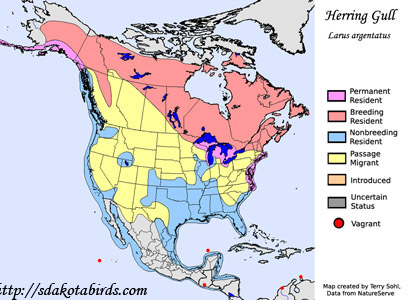 |
| South Dakota Status: Locally common migrant, most often near the Missouri River and its reservoirs. Uncommon winter resident along the Missouri River. |
Additional Herring Gull Photos
Click for a higher-resolution version of these photos
